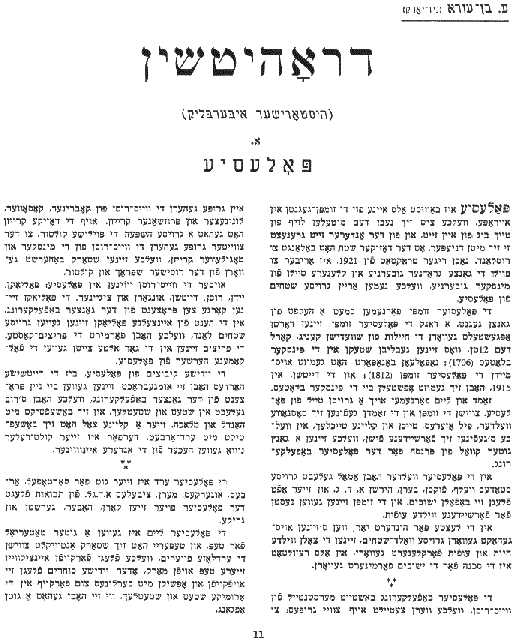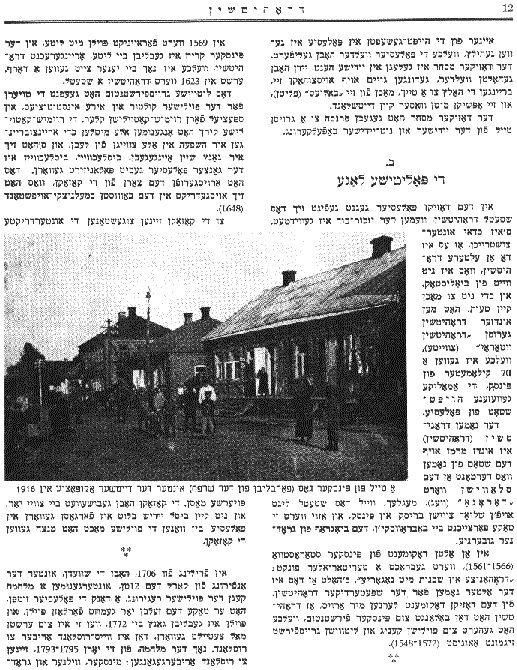Previous Page
|
Next Page
DROHITCHIN
(Historical Overview)
by E. Ben Ezra (New York)
 [
Page 11
]
[
Page 11
]
A.
POLESIA
Polesia is renown as one of the swamp areas of Europe, extending from the
middle of the Bug River on one side to the Dneiper River on the other. The area
used to belong to Russia; after the Riga Treaty of 1921, the entire Grodno
gubernia [province] and smaller areas of Minsk gubernia, including large areas
of Polesia, were transferred to Poland.
The swamps of Polesia covered almost half of the whole area. The Polesia swamps
were responsible for halting the armies of the Swedish king, Karl the Twelfth;
his armies got bogged down in the marshlands of Pinsk (1706). Napoleon
Bonaparte was forced to avoid the swamps (1812), and in 1915, the Germans were
forced to stop at the marshlands of Pinsk.
A large portion of Polesia is also made up of sand and clay. Between the swamp
and the sandy areas, there are pine forests, as well as many lakes, rivers and
streams in which a variety of fish can be found. These fish provided a good
source of income for the inhabitants of Polesia.
Great numbers of wolves, foxes, bears, deer and other such animals once lived
in the Polesia woods and very often they would attack the villages. The swamps
also provided nests for a variety of wild fowl.
In the last few hundred years, during which time great areas of the forest were
cut down, the number of wild animals and birds has decreased, and as a result
the danger to the villages has also decreased.
**
*
The inhabitants of Polesia are mostly White Russians, who can be divided into
two groups: the White Russians of the areas of Kobrin, Kosov, Luninets, and
Pruzhan, and Polish culture had a great influence on these people. The other
group is composed of White Russians from Minsk and Mogilev, and they were
greatly influenced by Russian language and culture.
In addition to the White Russians in Polesia, there are also Poles, Jews,
Russians, Germans, Hungarians and Gypsies. The Poles comprise almost ten
percent of the total population, and a few Poles, who formed the nobility,
owned large tracts of land. Many years ago, the nobles were the undisputed
rulers of Polesia. Until the German hordes exterminated them, the Jewish
communities in Polesia formed approximately nine percent of the entire
population. The majority of them lived in cities or villages, and occupied
themselves with business or trade. Only a small number of them were involved in
farming. This is why their cultural level was higher than that of the other
inhabitants.
**
*
The soil of Polesia is very good for growing potatoes, peas, cucumbers,
carrots, onions etc. Polesian peasants would plant rye, oats, barley and
buckwheat.
The clay of Polesia was good material for making pots, and pot-making was
widespread among the landless peasants, who used to individually sell their
pots in the market. Sometimes Jewish merchants would buy them up and send them
by boat to be sold in the surrounding cities or villages where they were very
popular.

[
Page12
]
One of the main sources of livelihood in Polesia was the lumber business; the
wood was furnished by the Polesia forests. Jews controlled this business; they
owned forests, hired gentiles to chop down the timber, take it to the river,
form it into rafts, and send it up river to Germany.
This business provided a livelihood for a large number of both Jews and
non-Jews.
[Photo caption:] Part of Pinsker Street (spared by the fire) during the German
occupation in 1916.
B.
THE POLITICAL SITUATION
The town of Drohitchin, which is the subject of this Yizkor Book, is located in
this area of Polesia. It is important to emphasize that there is an older
Drohitchin, which is located not far from Byalistock; so as not to confuse it
with our own town, our Drohitchin, was called The Second Drohitchin, and was
located 70 kilometers from Pinsk, the former capital city of Polesia.
The name Drogitchin (Drohitchin) indicates that the source of the name is the
Slavic word
doroga
(road). Perhaps this is because the village lies on the road between Brisk and
Pinsk. It is indeed in this way that Drohitchin is identified by Bobrofsky, the
chronicler of the gubernia of Grodno.
In an old document of the local government of Pinsk (1561-1566), there is
mention of a geographical location for the town: "Drohonitsa is near
Nagoria." I believe that this is the old name of what would later be
called Drohitchin. This particular document indicates that in those days
Drohitchin was part of the Duchy of Pinsk, which belonged to the Polish king
and Lithuanian Grand Duke, Sigmund August (1548-1572).
**
*
Poland and Lithuania were united in 1569, and the Pinsk region remained part of
Lithuania; this included Drohitchin, which at that time was only a village. It
did not become a small town until 1623.
The Grand Duchy of Lithuania opened its doors to Polish culture and
institutions, and especially to Roman Catholic culture. The Roman Catholic
Church used all available means to expand its influence in all areas of life,
and was very successful in that effort. The whole territory of Polesia was
gradually Polanized. This aroused the wrath of the Cossacks, which expressed
itself in the infamous Chmielnicki Massacres (1648).
The Cossacks were aided by the oppressed peasant masses. The Cossacks went on
the rampage for two years, and a great deal of Jewish blood was spilled in
Polesia until the Polish government vanquished the Cossacks.
**
*
In the spring of 1706, under the leadership of Karl the Twelfth, the Swedes
launched a war against the Polish government, but thanks, however, to the
swamps of Polesia, he had to leave Poland that same year, and Poland remained
intact until 1772, when the territory of Poland started to be partitioned. It
was at that time that White Russia reverted to Russia, and after the war –
between 1793 to 1795 - the gubernias of Minsk, Vilna and Grodno were also taken
over by Russia.
Previous Page
|
Next Page
This material is made available by JewishGen, Inc.
and the Yizkor Book Project for the purpose of
fulfilling our
mission of disseminating information about the Holocaust and
destroyed Jewish communities.
This material may not be copied,
sold or bartered without JewishGen, Inc.'s permission. Rights may be
reserved by the copyright holder.
JewishGen, Inc. makes no representations regarding the accuracy of
the translation. The reader may wish to refer to the original material
for verification.
JewishGen is not responsible for inaccuracies or omissions in the original work and cannot rewrite or edit the text to correct inaccuracies and/or omissions.
Our mission is to produce a translation of the original work and we cannot verify the accuracy of statements or alter facts cited.
 Drogichin, Belarus
Drogichin, Belarus
 Yizkor Book Project
Yizkor Book Project
 JewishGen Home Page
JewishGen Home Page
Yizkor Book Director, Lance Ackerfeld
This web page created by Lance Ackerfeld
Copyright © 1999-2025 by JewishGen, Inc.
Updated 3 Dec 2001 by LA

 [
Page 11
]
[
Page 11
]


